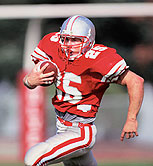
TUESDAY, Dec. 7 (HealthDay News) — Youth sports injuries have become rampant in the United States, with emergency departments treating more than 8,000 children a day for sports-related injuries, safety experts reported Tuesday.
As more children play school sports and in organized leagues, they are suffering an ever-increasing number of injuries, the experts from the National Athletic Trainers’ Association said in presenting their grim picture at a conference in Washington D.C.
Statistics released by the organization also revealed that:
- Forty-eight youths died as the result of sports injuries in the past year.
- About 63,000 high school athletes suffer brain injuries every year.
- High school athletes suffer 2 million injuries, 500,000 doctor visits and 30,000 hospitalizations each year, according to the U.S. Centers for Disease Control and Prevention.
The numbers led the association to issue a national report card on youth sport safety, giving the nation a C- for 2010.
“This is a neglected population in terms of focusing on health and safety during sports participation,” said Marjorie J. Albohm, president of the 30,000-member organization. “The numbers of young people far outweigh the numbers of elite or professional athletes, yet we haven’t given them the attention they deserve in terms of health and safety.”
Sudden cardiac arrest accounted for nearly half the deaths in the last year, while concussion accounted for three, heat illness three, and exertional sickling (a result of sickle cell trait, causing collapse due to muscle breakdown) caused one, according to the organization.
“Most coaches don’t really understand sickle cell and what can happen,” explained Brian Robinson, head athletic trainer at Glenbrook South High School in Glenview, Ill. “What you see is similar to heat stroke symptoms, but it can happen a lot faster.”
Robinson, who is also chairman of the association’s Secondary School Committee, called the youth sports injury situation a “public health issue,” because of the long-term ramifications of many of the injuries that kids suffer while playing sports.
For example, knee injuries, which are very common, can lead to arthritis later in life, according to Albohm. “An injury that a 14- or 16-year-old suffers can affect them for the rest of their lives,” she noted.
The association created the Youth Sports Alliance, along with about 40 other health and sports organizations, to push for legislation, and to educate coaches and others involved in youth sports to prevent injuries and provide appropriate medical services to injured athletes.
Additional data provided at the conference showed that:
- High school athletes suffer three times as many serious injuries as college athletes each year.
- Female high school basketball players sustain 240 percent more concussions than their male peers (13,000 annually)
- Sixteen percent of football players who lose consciousness after brain injuries return to play the same day.
Professional sports organizations such as Major League Baseball, the National Football League and the National Basketball Association typically have several athletic trainers working with other health-care professionals to determine whether an injured player can return to action or still needs medical attention. Most colleges and universities also have athletic trainers at sports events, said Albohm.
But below the college level, decisions about returning to play are made by coaches, who face pressure to win, Albohm explained.
“Coaches shouldn’t be making these decisions. It’s not their job to be health-care professionals,” said Albohm.
The association has worked since its inception to change what it sees as an often-stoic attitude toward injuries in athletics, Albohm added.
“We have been fighting the ‘playing through pain’ culture since as long as we’ve been in existence, since 1950, when the organization was founded,” she said.
“It’s the warrior mentality, and we see it every day in high school sports,” added Robinson. In addition to coaches who want to win, student athletes often hesitate to report an injury, or want to return to play to please the coach, he said. That is why the presence of a health-care professional is critical, both Albohm and Robinson said.
More information
Here’s more on high school sports injuries from the American Academy of Orthopaedic Surgeons.

